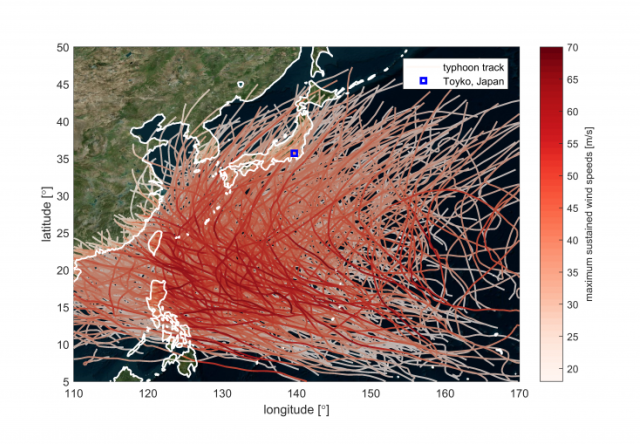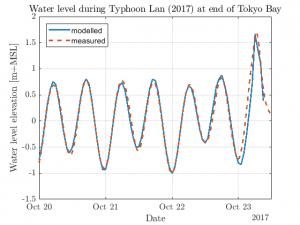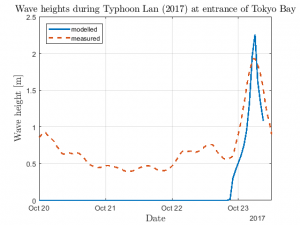How to prepare Tokyo Olympics 2021 for next super typhoon?
In an internal study, researchers from Deltares analysed the probability and possible consequences of typhoons during the Summer Olympics of 2021 in Tokyo, Japan, and what actions could be taken to minimise adverse consequences during the sporting event to the team and equipment.
Typhoons (also known as tropical cyclones or hurricanes) are among the most destructive natural disasters worldwide. Typhoons can cause hazardous weather conditions including extreme rainfall and wind speeds, leading to coastal hazards such as extreme storm surge and wave conditions. For example, the Typhoon Hagibis (2019) resulted in the cancellation of several professional sporting events including Rugby World Cup matches and the Formula One Grand Prix race.

While it is a certainty that typhoons hit Tokyo regularly (as illustrated by Typhoon Hagibis in 2019), it is uncertain if one might occur during the Olympics. We calculated the probability of a major typhoon hitting Tokyo during the Olympics to be 1 in 100 (being a 1% chance). Although this appears to be a low probability, to put this in perspective the probability of throwing 4 dices at once and getting four times the same number is 0.5%. Hence the occurrence of a typhoon has a low probability, however it is not unlikely.
There are two things we would advise:
Prepare
The location of the Olympic Village is near the Tokyo Bay and major rivers and the area has been identified as a flood prone area by the local government. Prepare by identifying high-lying dry and safe areas where staff and material can be transported to in case a typhoon would hit Tokyo, prior to departure. Flooding is expected in the low-lying areas near Tokyo Bay and local rivers. The latter is of importance since typhoons can also bring lots of rain, up to 250 mm per day during an event. In comparison, this is a third of the total rainfall in the Netherlands in a whole year! The further inland one goes, the more protected against wind and other natural hazards. One could consider back-up locations in the areas of western Tokyo, for instance near the Yoyogi National Stadium in the Shibuya ward.
Contact local authorities
The Japanese authorities and in particular the Japanese Meteorological Agency (JMA) are well prepared for these kinds of events. It would be wise to start the communication with JMA ahead of time. Moreover, follow the advice of JMA and other governmental agencies during the Olympics. Typhoon tracks are relatively unpredictable and up to 2 days out, the path the typhoon takes will vary substantially.
Background of study
Computer simulations with TCWiSE and Delft3D FM have reproduced 1000’s synthetic typhoon tracks (e.g. Figure 1) across the Northwestern Pacific Ocean and their effects on water levels and waves. Synthetic typhoon tracks are based on historical observations but include much more realizations of both more dis- and advantageous trajectories in terms of hazards. This approach allows for a more rigorous and reliable understanding of the risks associated with these events.

To gain confidence in the model results obtained from synthetic tracks, at first, several historical tracks (e.g. Typhoon Lan (2017), as well as typhoons Hagibis and Faxai that both occurred in 2019) are modeled and compared to observations. Water level measurements taken at multiple locations throughout the Tokyo Bay (published by the Japan Oceanographic Data Center) show good correspondence in both timing and amplitude to the modeled total water levels consisting of a tidal signal and typhoon-driven additional storm surge. Furthermore, maximum modeled wave heights at the entrance of Tokyo Bay show a good match with wave height observations published by NOWPHAS.


On average, there are 16 typhoons per calendar year in the Northwest Pacific Ocean. The typhoon high season is from July-October, but they can occur year-round. The probability that a typhoon passes Tokyo during the Summer Olympics within a 200 km radius is 20%. If a typhoon passes Tokyo, one should be prepared for severe wind speeds, high waves, and possible flooding of its low-lying areas. With a probability of 1 in 100 (1% chance), wind speeds will exceed the official criteria for typhoon wind speeds of 33 m/s (or 64 knots, 119 km/h) during the Olympics (Figure 4). Typhoon wind speeds could result in severe damage with loss of most of the roof structure and/or some exterior walls. Also, most trees will be snapped or uprooted, and power poles downed.

It is not just during the most extreme wind speeds, that adverse effects and damage could occur. For example, also with a probability of 1 in 100, wave heights during typhoon conditions will exceed 2.5 meters which will be dangerous for sailing matches at Enoshima Sailing Harbor. Moreover, water levels in the Tokyo Bay might reach an elevation close to 1.6 meters compared to the mean sea level (Figure 5). In combination with the possibility of overtopping waves, intense local rainfall and increased river discharge, this could contribute to flooding in Tokyo. In terms of rainfall, according to Kamahori et al. 2018, the annually expected maximum typhoon induced rainfall rate is up to 100 mm/day. The 50-year return period rainfall rate caused by typhoons induced is 250 mm/day according to the same research. This is a third of what falls in the Netherlands in a whole year.
Summarised
The Olympic Village, situated in the harbor area of Tokyo, is vulnerable to flooding during a super typhoon from the sea side of Tokyo Bay as well as the rivers due to rainfall because of its low-lying nature. Therefore, it is advised to be prepared for such an event and contact local authorities.


